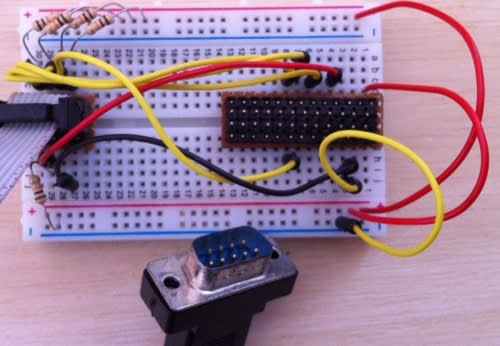Raspberry Pi joystick
Follow articleHow do you feel about this article? Help us to provide better content for you.
Thank you! Your feedback has been received.
There was a problem submitting your feedback, please try again later.
What do you think of this article?
After getting MAME going on my Raspberry Pi so that I could play old arcade games. I wanted to hook up a proper joystick. Back in the 80′s I had the excellent and ubiquitous Competition Pro 5000. As mine (foolishly) got sold with my Amiga stuff I got one on eBay, and it came in the original box:
The first step was to get it hooked up to the RPi general purpose input output (GPIO). I used a breadboard with my homebrew Pi Cobbler at one end and a similar connector at the other hooked up to an old PC serial card cable that has the right (male) DB9 connector for the joystick plug (female). It was then just a matter of adding some pull up resistors (10K) and some patch cables:
Since I was originally planning to use gpio-keys I used the joystick pinout to hook up to the RPi thus:
1. Up -> 11 (GPIO 17)
2. Down -> 13 (GPIO 22)
3. Left -> 15 (GPIO 23)
4. Right -> 16 (GPIO 24)
5. n/c
6. Fire -> 7 (GPIO 4)
7. n/c
8. GND
9. n/c
Blind Alley
Having already seen gpio-keys I thought I’d be using that, but when it came to the crunch I didn’t know where to start – I probably need a package of RPi kernel source. On reflection I probably really wanted gpio-mouse anyway.
After some digging around the Raspberry Pi Forums I found a comment about using Python to generate keystrokes. This got me headed in the direction of Python uinput, which is a module that can create keypresses.
sudo modprobe uinput
git clone https://github.com/tuomasjjrasanen/python-uinput
cd python-uinput
sudo python setup.py install --prefix=/usr/local
Smelling victory I knocked together some code that turns GPIO into keypresses. Sadly it seems that AdvMAME derives it’s input in such a way that completely ignores uinput for keyboard. Back to the drawing board.
The right(ish) approach
Digging around the examples for Python-uinput I found one for joystick, so I had a go at creating a GPIO connected variant, and with that saved as rpi-gpio-jstk.py it was a simple case of running:
sudo python rpi-gpio-jstk.py &
I tested using advj, and it showed input. When I fired up AdvMAME the joystick worked – horray – time for some gaming:)
Conclusion
I now have a working classic joystick for my classic games, and it seems to perform fine. I’m not entirely happy with the Python based approach, particularly as it uses polling, but I’ve seen nastier hacks. I’d still like to get a proper kernel module working, more so if it can use interrupts rather polling. I should probably also investigate using internal pullups so that I can simplify the wiring for when I make a more permanent (dual?) joystick adaptor.



